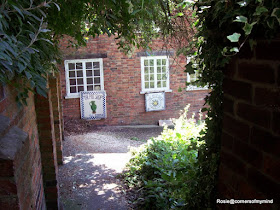This week has been quite busy so I haven't had time to do the second Newstead Abbey post yet. I'm hoping to get round to that later but today we are having some new fencing delivered which has to be put in place and also the lawn is long overdue a cut so I'm hoping this morning's rain is going to disappear so we can work in the garden over the next couple of days.

On Tuesday we went to Chesterfield to have lunch with my sister and to visit my brother-in-law in hospital where he is spending the next few days. On our way back we stopped for a break in
Bakewell and had a walk by the river......

.....through this pretty sensory garden near the bridge and looked in some of the shop windows - it's a good job they were closed as I in my imagination I spent pounds on some really pretty things!

On Wednesday we had arranged to meet up with friends from Nottingham for lunch and a walk around at Derby. We walked out of the city centre to the Arboretum, somewhere I'd never been before.

This is the present main entrance in Arboretum Square and as you walk up the street towards it you get the feel of how it may have looked when it first opened. It must have been very grand, some of the larger houses are divided into flats others are undergoing extensive renovation.

The arboretum, known locally as the '
arbo', was opened in 1840 and was created on land owned by Joseph
Strutt who gave the deeds to the town council of Derby on 16
th September of that year. The day after a procession of 1,500 towns folk walked to the arboretum to enjoy its first day of opening.

Behind the main entrance is the Orangery with the clock, which is on the back of the tower holding the statue of Joseph
Strutt overlooking the square. According to the 'Friends of the Arboretum' website there is a plan to stop parking
in front of the main entrance and make the orangery into an entrance arcade complete with orange trees.

The statue of the Florentine Boar, sculpted by Alex Paxton, was placed here in November 2005. It is a replica of the original statue of a boar, made for Joseph
Strutt's garden in 1808 but later moved to the arboretum, which was damaged in 1941. This boar was a copy of the boar fountain which sits on the edge of the
Mercato Nuovo in Florence. We missed seeing the Florentine Boar when we visited Florence - apparently if you rub its nose you will return, I expect the Derby boar will be the nearest I get to the original now.

The fountain was first placed here in 1846 but much of it has been replaced over the years due to damage and vandalism.

This is the Grove Street entrance to the arboretum which was, until the 1850s the main or Grand Entrance. The Lodge was used to house the curator of the arboretum.

According to the website Derby Arboretum was England's first designated public open space. Here is a link to the
website where you can find much more information about its history and future plans.




























































